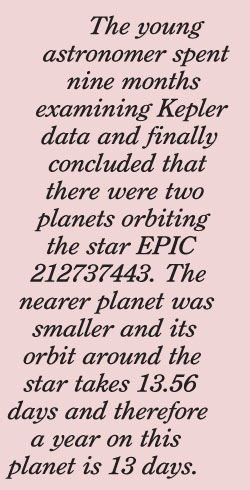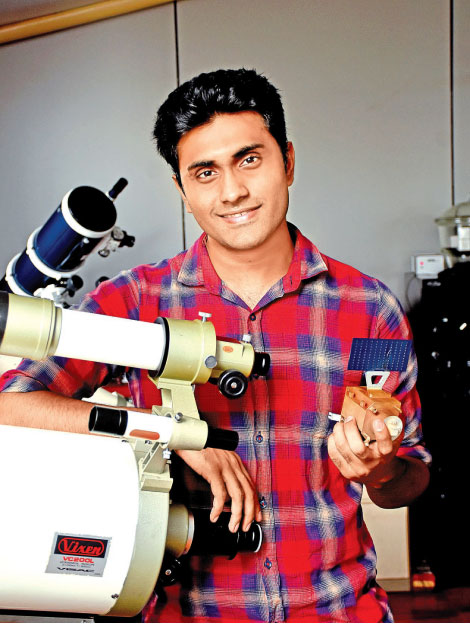
 Mahesh Herath, a 28 year old research scientist attached to the Arthur C Clarke Institute of Modern Technologies, (ACCIMT) University of Moratuwa is the latest Sri Lankan trailb lazer and game changer in space research. His discovery of two extra solar planets (exoplanets) orbiting a distant star has put Sri Lanka’s footprint on the map of space research. Astronomy and outer space exploration are not new subjects for Sri Lankans. In modern times our honorary citizen, British national, Sir Arthur C Clarke, Sri Lankans, Professor Cyril Ponnamperuma, and Dr. SarathGunapala and Professor Chandra Wickremasinghe have been globally acknowledged for their invaluable contributions to space research.
Mahesh Herath, a 28 year old research scientist attached to the Arthur C Clarke Institute of Modern Technologies, (ACCIMT) University of Moratuwa is the latest Sri Lankan trailb lazer and game changer in space research. His discovery of two extra solar planets (exoplanets) orbiting a distant star has put Sri Lanka’s footprint on the map of space research. Astronomy and outer space exploration are not new subjects for Sri Lankans. In modern times our honorary citizen, British national, Sir Arthur C Clarke, Sri Lankans, Professor Cyril Ponnamperuma, and Dr. SarathGunapala and Professor Chandra Wickremasinghe have been globally acknowledged for their invaluable contributions to space research.
Mahesh Herath made his historic discovery under the supervision and guidance of Professor of Physics, Colombo University, Dr. Chandana a Jayaratne and, Chief Research Scientist ACCIMT, Saraj Gunasekera.
Mahesh Herath read for his degree in physics at the University of Southampton, UK and then went on to do his master’s in space science at KU Leuven in Belgium. The course of study included spacecraft engineering, space law and statistics.
After obtaining his master’s Herath returned home and joined the University of Colombo as a Research Scientist in Astronomy and is now reading for his Mphil in planetary astronomy at the University of Colombo.
NASA’s Kepler/K2 Mission is a spacecraft with an extremely strong telescope which has observed 588991 stars.
In 2017, Saraj Gunasekera initiated a search for extra solar planets (exoplanets) using data from the Kepler telescope and Mahesh Herath joined as a research scientist. The third member of the team was Professor Chandana Jayaratne.
Mahesh Herath looked at around 30,000 files of Kepler data and finally, narrowed it down to 500 and further brought it down to 6-5. He also created a special algorithm for this.
Herath finally focused on a star named EPIC 212737443 (EPIC is the acronym for Ecliptic Place Input Catalogue). It is 1,133 light years away from Earth. When searching for planets astronomers study the dimming properties of the star concerned. When a planet passes across the face of a star there is a diminishing of the star’s brightness in relation to the size of the planet and this helps astronomers to calculate the features of the planet concerned.
The young astronomer spent nine months examining Kepler data and finally concluded that there were two planets orbiting the star EPIC 212737443. The nearer planet was smaller and its orbit around the star takes 13.56 days and therefore a year on this planet is 13 days. This planet was catergorised as K2 310 B .Its diameter is 33,165 km which is 2.6 more than the Earth and the distance between the star and planet is 0.1 astronomical units. It is certain that both planets have thick atmospheres due to their sizes relative to Earth. However, their exact composition is yet to be determined. As the temperature of this planet is 263 degrees centigrade it is unfit for human habitation.
The second and larger planet K2 310 C orbits around the star every sixty five days. It has a diametre of 34,441 km 2.7 times the size of the Earth. The distance between the star and the planet is 0.3 astronomical units.
As part of the exoplanet project, Mr Gunesekara and Professor Chandana Jayaratne supported, guided and supervised Mahesh Herath throughout the project and he acknowledges their invaluable contribution with great gratitude.
More hands were needed on the project and certain sections like studying the star was outsourced and Mahesh appreciates very much the support given by Tobias Hinse, and Jesus Hernandez Livingstone whose assistance and expertise were invaluable in the validation of the exoplanets.
The final findings were sent as a Research Paper to the Royal Astronomical Society in December 2018 where it was subjected to peer review and published in the Monthly Notices of the Royal Astronomical Society (MNRAS) in June 2019. The Sri Lankan team’s findings were now officially authenticated. This momentuous discovery was also published in the exoplanet archive run by NASA and CALTECH (California Institute of Technology). Other online listings include the Exoplanet Archive and the Extra Solar Planet Encyclopaedia.
Research Scientist Mahesh Herath (28) is an old boy of Royal College where he was involved in the school’s Astronomical Society and was the Vice President. His interest in space was inspired and fuelled by space art, space craft, science fiction stories and movies. He was also actively involved in the University of Southhampton’s Astronomical Association.
His interest in exoplanetary astronomy started when he was asked by a batch mate and good friend David at the University of Southhampton to help him with an exoplanet transit project. It needed two people to do it live while the exoplanet was going across the face of a star. The planet was a Jupiter type of planet.
Mahesh is now busy with his research and reading for his Mphil at Colombo University and looking at future projects would include the use of Artificial Intelligence in the search for Exoplanets.
This good looking guy loves to walk and has a beautiful memory of walking through a small forest end to end, while in Belgium. He says it was peaceful and lovely being close to the environment and wishes he could do it again. Apart from walking Mahesh loves to drive around at night enjoying the calm and quiet.
He maintains a strict diet and a trim figure with a sandwich lunch and a boiled veggie dinner but breaks his disciplined eating when out with friends indulging in the likes of pizza and pasta and lashings of ice cream.
Like most young men Mahesh favours jeans and T’shirts but reverts to formal attire when necessary.
I came away after our chat with the impression of a young man who was very well balanced with an extremely high IQ and whose phenomenal success has not gone to his head. A unique young man indeed and Youth Observer wishes him soaring successes in his chosen career.
Pix Gyan Pushpika
